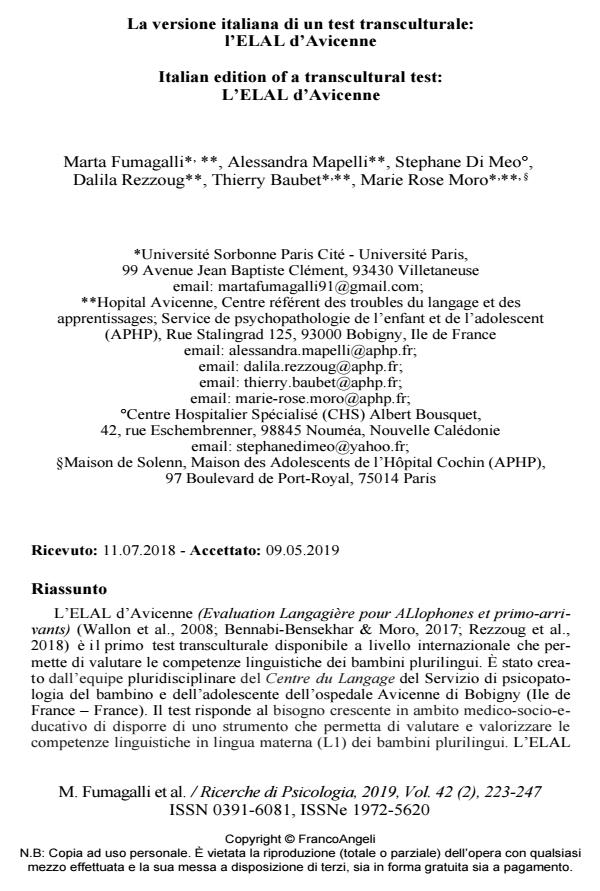Italian edition of a transcultural test: L’ELAL d’Avicenne
Journal title RICERCHE DI PSICOLOGIA
Author/s Marta Fumagalli, Alessandra Mapelli, Stephane Di Meo, Dalila Rezzoug, Thierry Baubet, Marie Rose Moro
Publishing Year 2019 Issue 2019/2
Language Italian Pages 25 P. 223-247 File size 380 KB
DOI 10.3280/RIP2019-002002
DOI is like a bar code for intellectual property: to have more infomation
click here
Below, you can see the article first page
If you want to buy this article in PDF format, you can do it, following the instructions to buy download credits

FrancoAngeli is member of Publishers International Linking Association, Inc (PILA), a not-for-profit association which run the CrossRef service enabling links to and from online scholarly content.
L’ELAL d’Avicenne (Evaluation Langagiere pour ALlophones et Primo-arrivants) (Wallon and al., 2008; Bennabi-Bensekhar and Moro, 2017; Rezzoug et al., 2018) is the first internationally available transcultural test to assess language skills of multilingual children. It was created by the multidisciplinary team of the Centre du Langage of the child and adolescent psychopathology service of the Avicenne Hospital in Bobigny (Ile de France-France). The test responds to the growing need of medical, social and educational professionals to have a tool that allows them to evaluate and enhance the language skills in mother tongue of multilingual children. L’ELAL d’Avicenne evaluates universally acquired simple concepts before the age of 6 years 5 month, which makes it accessible to children between the ages of 3 years 5 month to 6 years 5 month. The study aims to present the process of translation of a transcultural test in Italian and to present the final product: the test L’ELAL d’Avicenne translated into Italian. The translation process consists of two levels: 1. translation of the original version of the test into Italian and, 2. its application to a sample of 20 monolingual Italian children in a context where Italian is the predominant mother tongue. The final results highlight an inferential equivalence of the original and the final version of the test L’ELAL d’Avicenne in Italian for every step: production, understanding and production of a story.
Keywords: Ttranslation, transcultural test, italian language, mother tongue, multilingualism
- Vers une équité en santé mentale pour les enfants de migrants : propositions transculturelles M.R. Moro, R. Radjack, in Bulletin de l'Académie Nationale de Médecine /2022 pp.766
DOI: 10.1016/j.banm.2022.01.026 - Il bilinguismo nei bambini con background migratorio Giovanni Giulio Valtolina, in RICERCHE DI PSICOLOGIA 1/2024 pp.27
DOI: 10.3280/rip2024oa18560
Marta Fumagalli, Alessandra Mapelli, Stephane Di Meo, Dalila Rezzoug, Thierry Baubet, Marie Rose Moro, La versione italiana di un test transculturale: l’ELAL d’Avicenne in "RICERCHE DI PSICOLOGIA " 2/2019, pp 223-247, DOI: 10.3280/RIP2019-002002